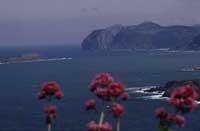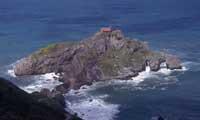Basque Coast (XII): Cliffs of Bizkaia (I)
When we study the marshes and the beaches we talk a lot about the diversity of the vizcaínos. As for cliffs, geomorphological, geological and biological diversity is also superior to that studied in Lapurdi and Gipuzkoa. It seems logical since here there are more geological units and greater extension of coast, although in general the length of the cliff sections is less than in Bizkaia, Lapurdi and Gipuzkoa. The characteristics that we have already studied will be mentioned here only with soslaris and will be treated mainly the most unique and original aspects of the cliffs of Bizkaia.
From Lekeitio to Bermeo
The coast that extends between the two great ports of Bizkaia is the area of the Biscayan anticlinical coast. They are cliffs of the station Aptiense of the lower Cretaceous and its most remarkable feature is the presence of large rocky masses of clayey sandstones practically unstratified. As a result and due to the abundance of gears, this stretch of coast is blue grey.
At first glance it may surprise the lack of stratification. The cause of this phenomenon lies in the origin of stone. In fact, although the sedimentary origin has been mentioned in the regions studied so far, in this stretch of coast that extends from Lekeitio to Bermeo highlights its biological origin. In the lower Cretaceous, all Euskal Herria was under the sea and the corals of this part and the dolmens of the rudists. The push that lifted the Pyrenees caused the dolmens to also reach the surface and become trapped by erosive agents.

The rocks generated in this process are called Biohermos and it is an observable phenomenon not only in this part of the coast, but also in other places of Bizkaia. The hardness of the bioherms makes the erosion speed much slower on these cliffs. Thus, on the bases of these rocks considered as the cape of our coast we will hardly find large platforms of abrasion. The cliffs are high and very vertical.
Although bioherms predominate in this part of the Biscayan coast, other components can also be found, which normally appear to form small coves or bays.
In this coastal stretch you can find three biohermes: Mount Otoi and the cliffs between the cove of Lekeitio and Ogella, the cliffs between Cape Ermitxo and the Ria de Ea and the spectacular cape of Ogoño.
From the geological point of view it is worth highlighting the presence of two diapiro. Due to the high erosion of the stones, the coast recedes noticeably and its effect is accentuated because both diapiros are located next to the cape of Ogoño. The first one has created the bay and the small port of Elantxobe and the second, with greater size, has affected the estuary of Urdaibai, an ecologically privileged environment. In Urdaibai itself and in the center of Lekeitio Bay two other spectacular consequences of the erosive differential appear: Izaro and San Nicolás Islands.
If you are going to make an ecological observation, you will hardly find in this coastal stretch an extensive and important intertidal ecosystem, as mentioned and due to the peculiar lithology of these cliffs, since the erosion is relatively slow, so the delay of the coastline occurs very slowly.
As for the cliff ecosystem, however, the situation is completely different. As mentioned above, these rocks are very high and large, allowing a good observation of all levels of these ecosystems, where you can observe practically all the plant species characteristic of the cliffs. The plant association Crithmo-Limonietum binervosis, composed of the plant species Limonium binevorsum, stands out especially since its most complete and spectacular representatives are found in these large calcareous rocks.
These are the nuances directly related to the cliff ecosystem, but let us not forget that the most extensive and structured holm oaks of the entire Basque coast are here: Lumentxa, Otoio, Ogoño, Urdaibai, etc.

As for the fauna, the most curious part that we find in this coastal stretch is the presence of some species of birds, quite scarce among us, in the large rocks that we have previously studied, or the nesting of the island of Izaro. Thus, we can see the Cormoran moñudo ( Phalacrocorax aristotelis), the European Country ( Hydrobates pelagicus), the Peregrine Falcon ( Falco peregrinus) or the Blue Rocker ( Monticola solitarius) in this environment. In addition, there are adequate isolation conditions in Ogoño and Izaro, which has allowed the development of large nesting colonies of yellow-legged gull ( Larus cachinnans) and shadowy gull ( Larus fuscus).
From Bermeo to Gaztelugatxe
Despite the succession of the previous one and the few existing kilometers, there is a main reason to analyze separately this small stretch of coast: Again appears the dark Flysch formed by marls and sandstones of the Middle Cretaceous that extends from the cape of Endata to Lekeitio. Don't surprise the reader! In fact, the presence here of the Flysch structure has certain particularities in the midst of repentance, among which the stratification of the layers stands out.
On the other hand, the erosion differential has led to the most emblematic cape of our coast, Cape Matxitxako. As for ecology, however, there are no special phenomena in this environment. In general, it can be said that only small platforms of abrasion and plants and animals typical of this area appear.
From Gaztelugatxe to Bakio
In the coastal strip that runs from the imposing Gaztelugatxe cove to the cliffs on the right bank of Bakio, Cape Ogoño predominates. Another characteristic that has already been mentioned of Mount Otoio or Cape Ermitxo is its biological origin due to the existence of a dolmen of rock formed by corals and rudists.

The calcareous bioherm is very hard and, like in the stretch from Lekeitio to Bermeo, it faces erosion of the drawer. However, the entire cliff does not have the same degree of hardness and here it can be said that the erosion differential is quite evident. The stretch of coastline is covered with small rocks and the beautiful Aketx and Gaztelugatxe islands are the clearest examples.
The high and vertical cliffs dominate again and appear almost all levels and plant species of these ecosystems. In addition, it is noteworthy that the isolation conditions of the island of Aketx are optimal for some animals to find their location. This is the case of the new colonies of gull, as well as the Cormorants moñudos ( Phalacrocorax aristotelis), quite rare on our coasts, and of the smaller Country ( Hydrobates pelagicus).
In abrasion platforms, however, this type of remarkable phenomena does not occur, as already mentioned, given the relatively low erosionability of this type of rocks, the delay of the coastline occurs very slowly, so the intertidal ecosystem does not cover large surfaces.
Although not to be said, the landscape value of this area is here and anywhere, since the landscape formed by the rocks of Aketx and Gaztelugatxe with cape Matxitxako is really beautiful.





